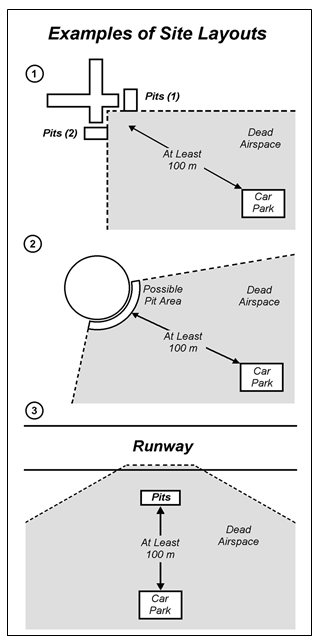11.1 Introduction
A study of the incident reports received by the BMFA shows that many accidents are either caused or made worse by poor flying site layout, lack of thought about flight patterns or general lack of flying discipline.
The following section sets out the lessons learned in general terms and it gives a framework in which the general safety code can work to its best advantage. These guidelines are advisory as every flying site has its own particular circumstances.
It is strongly recommended, however, that all R/C power oriented clubs, both fixed wing and helicopter, study this section and see how their sites and practices compare with the guidelines, especially with respect to the provision of ‘dead airspace’.
11.2 Layout
(a) Set up a car park separate from the pits area and, if possible, arrange for it to be at least 100 metres from the take-off/landing area, and behind the pits. Some sites do not allow the car park to be positioned this far away from the flying area but you should make an effort to position it as far away as practicable. If your site allows, you will find it useful to position your car park near some obstacle to flying such as trees or a high hedge.
(b) Enforce a strict ruling of no cars in the pits area. An exception could be made for any of your disabled members but only for loading and unloading.
(c) Have at least two recognised pits areas available so that the pits can be set up crosswind from the active runway whatever the wind direction and, if possible, at least 30 metres from the take-off/landing path. Under no circumstances allow models to take-off from or land over or towards the active pits area.
(d) Some field layouts may mean that your approach road cannot be included in the dead airspace you define. In these cases you must take extra care to have a laid-down method of driving on to the field and you should make sure that all your members are carefully briefed and aware of the safety situation

11.3 Flight Patterns
(a) Do not allow flying all around the field ‘control line’ fashion. Lay out an area of dead airspace that takes in the pits area, the car park, the approach to the field and any noise or safety sensitive areas which you need to avoid. The dead airspace area will usually be a segment of at least 90o and could be up to 180o i.e. all flying takes place one side of a line through the strip with the pits, car park etc. on the other side. It is vital to set up this area of dead airspace, even if your field is totally unobstructed all around.
(b) Enforce a strict rule that NO-ONE flies in the ‘dead airspace’ at ANY height.
(c) Specify that any flying actually over the take-off/landing area must be into wind only (except in an emergency or when practising with no other models airborne). This avoids conflicting flight patterns over the active runway but does not prohibit other styles of flying away from it.
11.4 Notes
Section 13.3 above has certain implications, the main one being that the circuit flown at any time will depend on the wind direction. For instance, if the prevailing wind is westerly and this gives you a left hand circuit on your field, a change in the wind to easterly means that you must fly a right hand circuit.
Because of this your members will have to become proficient in both left and right hand circuits and will have to be able to land either from their left or their right. None of this should bother most reasonably competent club flyers or any newcomer trained to fly like that from the start but a few flyers, even some quite experienced ones, may need encouragement and help to break old habits and begin flying in a slightly more disciplined style.
Once settled into this more disciplined style, your members may find that it is easier to fly this way.
Please note that this section refers to club flying sites only.
Next Section 12. LEARNING TO FLY RADIO CONTROL